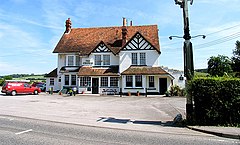Lower Basildon
| Lower Basildon | |
|---|---|
 Typical Building Style |
|
| Lower Basildon shown within Berkshire | |
| OS grid reference | SU609787 |
| Civil parish | |
| Unitary authority | |
| Ceremonial county | |
| Region | |
| Country | England |
| Sovereign state | United Kingdom |
| Post town | READING |
| Postcode district | RG8 |
| Dialling code | 01491 |
| Police | Thames Valley |
| Fire | Royal Berkshire |
| Ambulance | South Central |
| EU Parliament | South East England |
| UK Parliament | |
Lower Basildon is a small village in the civil parish of Basildon, near to Pangbourne, in the English county of Berkshire. It is the location of the parish church of St Bartholomew. The National Trust property, Basildon Park, is just above it. To the south-east of the village is the wildlife garden Beale Park.
Basildon Grotto, or The Grotto House, is located 0.8 miles (1.3 km) to the west on the road to Streatley. The grotto was built in 1720 and consisted of a rock chamber filled with shells and a rock pool, but was later destroyed. The summer house was extended at the beginning of the 19th century by Arthur Smith MP. It is currently the headquarters of ISPAL (the Institute for Sport, Parks and Leisure).
Upper Basildon has a sub-post office (located in St Stephen's Church) and a pub-restaurant - The Red Lion. Lower Basildon currently has a garage/shop and a motor repair business.
The remains of a modest Roman villa were discovered here in 1839 during the construction of the Great Western Railway. The major finds were two superb mosaic floors which unfortunately were destroyed almost immediately, although one was drawn in some detail beforehand by the antiquarian Charles Roach Smith. Nothing of the villa remains today.
The agriculturist Jethro Tull was born in the parish of Basildon and is buried in the churchyard of St Bartholomew's Church in Lower Basildon, under a modern gravestone incorrectly dated 1740 – he died in 1741. Tull developed his ideas at a farm called Prosperous at Shalbourne, just south of Hungerford.
...
Wikipedia

